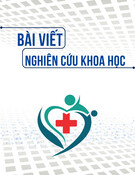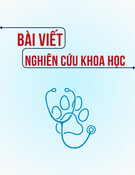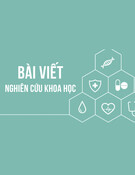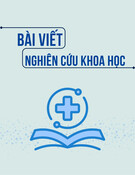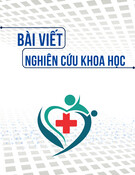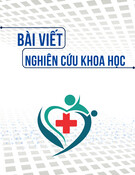
21
Đánh giá Rối loạn Giấc ngủ Thai phụ ba tháng
cuối thai kỳ và các yếu tố liên quan tại Trung tâm
y tế thành phố Thuận An
Ngô Văn Tuấn*, Vũ Thị Nhung**
Tóm tắt
Mục tiêu nghiên cứu: Xác định tỷ lệ rối loạn giấc ngủ ở thai phụ có tuổi thai từ 28 đến 40 tuần và
các yếu tố liên quan theo thang điểm Pittsburgh.
Phương pháp nghiên cứu: Nghiên cứu cắt ngang trên 375 thai phụ tuổi thai từ 28 đến 40 tuần, tại
trung tâm y tế thành phố Thuận An, tỉnh Bình Dương từ tháng 1/2021 đến 6/2021. Trong đó, các
đối tượng nghiên cứu trả lời câu hỏi khảo sát Pittsburgh về chỉ số chất lượng giấc ngủ.
Kết quả nghiên cứu: Tỷ lệ thai phụ có RLGN là 61,3%, trong số đó đa số là rối loạn mức độ nhẹ
(48,8%). Các yếu tố nguy cơ làm tăng tỷ lệ rối loạn giấc ngủ là (a): sử dụng điện thoại trên giường
ngủ so với không sử dụng (RR: 2,48, KTC95%: 1,57-3,93); (b): tiền sử thai kỳ nguy cơ cao so với
tiền sử thai kỳ bình thường (RR: 1,94, KTC95%: 1,22-3,06); (c): thai phụ dư cân và béo phì so với
thai phụ gầy (RR: 2,78, KTC95%: 1,15-6,72); và (d): thai phụ có tuổi thai 37-40 tuần so với tuổi
thai 28-32 tuần (RR: 2,34 KTC95%: 1,32-4,16).
Kết luận: Tỷ lệ rối loạn giấc ngủ ở phụ nữ mang thai ba tháng cuối cao, sử dụng điện thoại trên
giường ngủ, tiền sử thai kỳ nguy cơ (từng bị thai lưu, sẩy thai, đau bụng, tiền sản giật), thừa cân,
tuổi thai lớn được xem là những yếu tố liên quan có ý nghĩa đến chất lượng giấc ngủ kém.
Từ khóa: rối loạn giấc ngủ thai kỳ, rối loạn giấc ngủ, mất ngủ, điện thoại trước khi ngủ.
Evaluation of sleep disorders in the last trimester of pregnancy and related factors
at Thuan An city health center
Ngo Van Tuan, Vu Thi Nhung
Abstract
Objectives: Determine the rate of sleeping disorders in pregnant women with gestational age from
28 to 40 weeks and related factors on the Pittsburgh scale.
Methods: Cross-sectional study on 375 pregnant women with gestational age from 28 to 40 weeks,
at medical center of Thuan An city, Binh Duong province from January 2021 to June 2021. In this
study, participants answered Pittsburgh survey questions about sleep quality index.
Results: The rate of pregnant women with dyslexia is 61.3%, of which most of them are mild
disorders (48.8%). The risk factors for increased rates of sleep disturbance were (a): cell phone use
in bed versus no use (RR: 2.48, 95% CI: 1.57-3.93); (b): history of high-risk pregnancy compared
with history of normal pregnancy (RR: 1.94, 95% CI: 1.22-3.06); (c): overweight and obese women
compared with thin women (RR: 2.78, 95% CI: 1.15-6.72); and (d): pregnant women with a
gestational age of 37-40 weeks compared with a gestational age of 28-32 weeks (RR: 2.34 CI95%:
1.32-4.16).
Conclusion: The prevalence of sleep disorders in women in the third trimester of pregnancy is high. cell
phone use in bed, history of high-risk pregnancy (previous stillbirth, miscarriage, abdominal
pain,preeclampsia overweight , large babies were found to be significantly associated with poor sleep
quality.
Key words: Sleep disturbances in pregnancy, sleep disorder, insomnia, bedtime Mobile Phone .
*Bệnh viện Thuận An. DĐ: 0988344369,
Email: tuan0988344369@gmail.com;

22
SỨC KHỎE SINH SẢN
Đặt vấn đề
Tỷ lệ người lớn có rối loạn giấc ngủ (RLGN) ở
Hoa Kỳ từ 35-50% dân số.1Khi mang thai có
nhiều thay đổi về cơ thể học của thai phụ ở cơ
xương khớp, tim mạch, hô hấp, tiêu hóa, tiết
niệu, nội tiết và tâm lý,2,3 điều này dự báo tỷ lệ
RLGN diễn ra trong thai kỳ cao và phức tạp
hơn. Có nhiều yếu tố nguy cơ làm tăng tỷ lệ
RLGN trong thai kỳ như rối loạn nhịp thở khi
ngủ,4hội chứng chân không ngủ yên,5rối loạn
hành vi giấc ngủ REM,6trào ngược dạ dày thực
quản.7Ảnh hưởng của rối loạn giấc ngủ đến kết
cục bất lợi cho thai phụ và thai nhi đã được tìm
thấy như trong một phân tích gộp của tác giả
Qingdong Lu năm 2020 cho thấy RLGN làm
tăng tỷ lệ tiền sản giật lên 2,8 lần, đái tháo
đường thai kỳ tăng 1,59 lần, sanh non tăng 1,38
lần, sanh mổ tăng 1,47 lần.8Theo nghiên cứu
của Lương Ngọc Lan tại bệnh viện Hùng
Vương thì tỷ lệ RLGN là 58,67%,9, đây là tỷ lệ
khá cao. Thuận An là thành phố thuộc tỉnh
Bình Dương, dân sinh sống ở đây chủ yếu là
người nhập cư, làm công nhân tại các khu công
nghiêp, điều kiện kinh tế còn tương đối khó
khăn. Năm 2020, có 1787 thai phụ sanh tại
trung tâm y tế Thuận An, chưa có nghiên cứu
nào về RLGN nên việc nghiên cứu về vấn đề
này là cần thiết với câu hỏi nghiên cứu “tỷ lệ
rối loạn giấc ngủ của thai phụ tuổi thai từ 28
đến 40 tuần đến khám thai tại trung tâm y tế
thành phố Thuận An là bao nhiêu và các yếu tố
liên quan là gì?”
Mục tiêu nghiên cứu.
1. Xác định tỷ lệ thai phụ với tuổi thai từ 28
đến 40 tuần có rối loạn giấc ngủ theo chỉ số
Pittsburgh.
2. Xác định các yếu tố liên quan đến chất lượng
giấc ngủ kém theo chỉ số chất lượng giấc ngủ
Pittsburgh (chọn điểm cắt PSQI≤ 5 là có giấc
ngủ tốt, PSQI 5 là có giác ngủ chưa tốt).
Đối tượng - phương pháp nghiên cứu.
Thiết kế nghiên cứu: cắt ngang.
Đối tượng nghiên cứu (ĐTNC):
Thai phụ có
tuổi thai tù 28 đến 40 tuần đến khám tại trung
tâm y tế thành phố Thuận An từ tháng 1 đến
tháng 6 năm 2021.
Tiểu chuẩn nhận vào: đơn thai, tuổi thai từ 28
đến 40 tuần (theo kinh cuối nếu chu kỳ kinh
đều 28 đến 30 ngày hoặc theo siêu âm quý 1),
nghe hiểu Tiếng Việt và chấp thuận tham gia
nghiên cứu.
Tiêu chuẩn loại trừ: thai lưu, có bệnh lý cần
được cấp cứu, mất ngủ đã được chẩn đoán, bị
bệnh tâm thần, thai di tật, không trả lời đầy đủ
bảng câu hỏi của nghiên cứu viên.
Phương pháp chọn mẫu và thu thập số liệu:
Phương pháp chon mẫu: Chọn mẫu thuận tiện.
Công cụ nghiên cứu:Bảng câu hỏi được soạn
sẵn gồm hai phần.
Phần 1: gồm các đặc điểm chung của đối tượng
tham gia (tuổi mẹ, địa chỉ, chiều cao, cân nặng,
trình độ học vấn, nghề nghiệp, tình trạng hôn
nhân), đặc điểm thai kỳ (tuổi thai, số lần sanh,
tiền sử thai kỳ nguy cơ cao). Một số biến số đặc
biệt như có sử dụng điện thoại, Ipad trong 30
phút trước khi đi ngủ, tiếp xúc khói thuốc lá
Định nghĩa biến số :
–Sử dụng điện thoại liên quan đến giờ đi ngủ:
sử dụng điện thoại trong vòng ≤ 30 phút
trước khi lên giường ngủ và/hoặc khi lên
giường ngủ mà vẫn dùng điện thoại, máy
tính bảng cho các hoạt động như chơi zalo,
facebook, xem các trang thông tin xã hội,
xem video > 3 lần/tuần; các trường hợp còn
lại là không sử dụng điện thoại trước khi đi
ngủ.
–Tiền sử thai kỳ nguy cơ cao: đã từng bị thai
lưu, sẩy thai, tiền sản giật, đái tháo đường
thai kỳ, sanh mổ.
Phần 2: ĐTNC trả lời bảng khảo sát chỉ số chất
lượng giấc ngủ Pittsburgh (PSQI) của tác giả
Buysse và cộng sự (1989). Điểm số Pittsburgh
là điểm tổng hợp bảy thành phần được tính dựa
trên bảng câu hỏi Pittsburgh, bảng câu hỏi chất
lượng giấc ngủ của Pittsburgh gồm 9 câu hỏi

23
Bảng 1. Đặc điểm chung của thai phụ
Đặc điểm N=375 Tỷ lệ (100%)
Tuổi mẹ
35 tuổi
301
80,3
≥ 35 tuổi
74
19,7
Dân tộc
Kinh
363
96,8
Khác
12
3,2
Tôn giáo
Không
324
86,4
Có (Phật,
51
13,6
Tiền sử thai nguy
Không
177
47,2
Có
198
52,8
Tiếp xúc khói
Không tiếp xúc
253
67,5
Có tiếp xúc
122
32,5
Sử dụng ĐT liên
Không
136
36,3
Có
239
63,7
Nơi cư trú.
Bình Dương
93
24,8
Nơi khác đến
282
75,2
Trình độ học vấn.
Cấp 1
14
3,7
Cấp 2
189
50,4
Cấp 3
134
35,7
Trên cấp 3
38
10,1
Nghề nghiệp.
Nội trợ
95
25,3
Công nhân
256
68,3
Buôn bán
12
3,2
Khác
12
3,2
BMI.
18,5
36
9,6
18,5-24,9
261
69,6
≥ 24,9
78
20,8
Số lần mang thai.
0
142
37,9
1
214
57,1
≥ 2
19
5,1
Tuổi thai.
28-32 tuần
90
24,0
32-34 tuần
126
33,6
36-40 tuần
159
42,4
Nhận xét: Đa số ĐTNC là người dân từ địa
phương khác đến, nghề nghiệp là công nhân.
chấm điểm dựa trên thang điểm Likert 4 (0 – 3
điểm). Sau khi phỏng vấn thai phụ, bảng câu
hỏi sẽ được phân tích để tính ra bảy điểm số
thành phần, mỗi thành phần có bốn mức điểm
(0 - 3 điểm). Bảy điểm thành phần của PSQI
dùng để đánh giá các kiểu rối loạn giấc ngủ bao
gồm: 1) Rối loạn chất lượng giấc ngủ do thai
phụ tự đánh giá; 2) Rối loạn khó đi vào giấc
ngủ; 3) Rối loạn số giờ ngủ ít; 4) Rối loạn hiệu
quả giấc ngủ trong khi ngủ (%); 5) RLGN thức
giấc trong đêm; 6) RLGN phải dùng thuốc ngủ;
7) Rối loạn các hoạt động ban ngày.
Chỉ số Pittsburgh có điểm số từ 0 – 21, điểm số
≤ 5 có chất lượng giấc ngủ bình thường, điểm
5 có rối loạn giấc ngủ. Điểm cao hơn cho thấy
mức độ RLGN nặng hơn, PSQI có độ nhạy là
89,6% và độ đặc hiệu là 86,5% tại điểm cắt 5.10
Chỉ số Pittsburgh được tác giả Tô Minh Ngọc
dịch sang ngôn ngữ Tiếng Việt dưới sự cho
phép của đại học Pittsburgh và được chứng
minh có độ nhạy 87,76% và độ đặc hiệu 75%.11
Thu thập số liệu:
Nghiên cứu viên thu thập số liệu là một bác sĩ
và hai nữ hộ sinh phòng khám thai (đã được tập
huấn, có phỏng vấn thử 10 trường hợp để điều
chỉnh các câu hỏi cho thai phụ dễ hiểu). Thai
phụ đồng ý tham gia nghiên cứu đều ký giấy
đồng ý tham gia trước khi được phỏng vấn,
phỏng vấn mỗi đối tượng khoảng 10 phút, thai
phụ có RLGN nhẹ (PSQI 6 – 9 điểm) được bác
sĩ tư vấn các liệu pháp điều trị không dùng
thuốc, thai phụ có rối loạn mức độ trung bình
và nặng (PSQI 9) sẽ được giới thiệu khám
nội thần kinh. Thời gian thu thập số liệu là các
ngày hành chánh trong tuần (từ thứ 2 đến thứ 6).
Y đức: Nghiên cứu tiến hành sau khi thông qua
quyết đinh số 407/HĐĐĐ-TĐHYKPNT ngày
04/12/2020 của Hội Đồng Đạo Đức Trong
Nghiên Cứu Y Sinh Học - trường đại học Y
Khoa Phạm Ngọc Thạch.
Kết quả
Đặc điểm chung của ĐTNC (bảng 1):
Phân loại mức độ rối loạn giấc ngủ
Pittsburgh (bảng 2).
Bảng 2. Phân loại mức độ rối loạn giấc ngủ
Phân mức độ RLGN theo PSQI
N=375
Tỷ lệ
(100%)
Bình thường (0 – 5)
145
38,7
RLGN nhẹ (6 – 9)
183
48,8
RLGN trung bình (10 – 14)
43
11,5
RLGN nặng (15 – 21)
1,1
1,1
Nhận xét: Đa số ĐTNC có RLGN nhẹ

24
SỨC KHỎE SINH SẢN
Rối loại giấc ngủ theo các thành phần chỉ số Pittsburg (bảng 3).
Bảng 3. Phân mức độ các kiểu RLGN theo Pittsburgh.
Đặc điểm
0 điểm
n(%)
1 điểm
n(%)
2 điểm
n(%)
3 điểm
n(%)
Chất lượng giấc ngủ tư đánh giá (I)
41(10,9)
264(70,4)
62(16,5)
8(2,1)
RLGN kiểu đi vào giấc ngủ (II)
27(7,2)
193(51,5)
123(32,8)
32(8,5)
Thời lượng ngủ tự đánh giá (III)
188(50,1)
144(38,4)
40(10,7)
3(0,8)
Hiệu quả thời lượng ngủ (IV)
104(27,7)
256(68,3)
15(4,0)
0(0)
Rối loạn thức giấc trong đêm (V)
0(0)
188(50,1)
172(45,9)
15(4,0)
Rối loạn dùng thuốc ngủ (VI)
353(94,1)
22(5,9)
0(0)
0(0)
Rối loạn giấc ngủ ban ngày (VII)
136(36,3)
144(38,4)
58(15,5)
37(9,9)
Nhận xét: Đáng chú ý 100% ĐTNC thức giấc trong đêm, khó đi vào giấc ngủ 92%.
Phân tích đơn biến(bảng 4).
Bảng 4. Kết quả phân tích đơn biến các yếu tố liên quan RLGN.
Yếu tố
Điểm PSQI
RR (95%CI) p*
≤ 5
n=145(38,7)
5
n=230 (61,3%)
Tiền sử thai sản nguy cơ
Không
86(22,9)
91(24,3)
1
Có
59(15,7)
139(37,1)
2,23(1,46-3,40)
0,00*
Sử dụng điện thoại liên quan giấc ngủ
Không
74(19,7)
62(16,5)
1
Có
71(18,9)
168(44,8)
2,84(1,83-4,47)
0,00*
Tuổi thai
28 - 32 tuần
40(10,7)
50(13,3)
1
32 - 36 tuần
63(16,8)
63(16,8)
0,80(0,47-1,38)
0,42
36 - 40 tuần
42(11,2)
117(31,2)
2,23(1,29-3,84)
0,00*
BMI
<18,5
20(5,3)
16(4,3)
1
18,5 – 24,9
101(26,9)
160(42,7)
1,98(0,98-4,00)
0,06
≥ 24,9
24(6,4)
54(14,4)
2,81(1,25-6,35)
0,01*
Nhận xét: Bảng thể hiện các yếu tố nguy cơ làm tăng tỷ lệ RLGN ở ĐTNC.
Phân tích đa biến (bảng 5)
Bảng 5. Kết quả phân tích đa biến các yêu tố liên quan RLGN
Yếu tố
Điểm PSQI
RR (95%CI) p*
≤ 5
n=145 (38,7%)
5
n=230 (61,3%)
BMI
<18,5
20(5,3)
16(4,3)
1
18,5 – 24,9
101(26,9)
160(42,7)
1,94(0,90-4,18)
0,09
≥ 24,9
24(6,4)
54(14,4)
2,78(1,15-6,72)
0,02*
Tiền sử thai sản nguy cơ
Không
86(22,9)
91(24,3)
1
Có
59(15,7)
139(37,1)
1,94(1,22-3,06)
0,00*
Sử dụng điện thoại liên quan giấc ngủ
Không
74(19,7)
62(16,5)
1
Có
71(18,9)
168(44,8)
2,48(1,57-3,93)
0,00*
Tuổi thai
28 - 32 tuần
40(10,7)
50(13,3)
1
32 - 36 tuần
63(16,8)
63(16,8)
0,84(0,48-1,49)
0,55
36 - 40 tuần 42(11,2) 117(31,2) 2,34(1,32-4,16) 0,00*
Nhận xét: Bảng thể hiện các yếu tố nguy cơ
làm tăng tỷ lệ RLGN cho ĐTNC sau khi phân
tích loại bỏ các yếu tố gây nhiễu, yếu tố cùng
tác động.
Bàn luận
Đặc điểm của ĐTNC
Tuổi mẹ trung bình 28,8±5,8 tuổi, đa số dưới
35 tuổi (80,3%) phù hợp với đặc điểm dân số

25
độ tuổi sinh sản; BMI trung bình 22,2 ± 3,3;
đa số là công nhân; chưa học xong cấp 3;
75,2% là dân nhập cư; 63,7% có sử dụng
điện thoại liên quan giờ ngủ; 52,8% có tiền sử
thai sản nguy cơ cao; tuổi thai trung bình
34,7 ± 3,6 tuần.
Đặc điểm các thành phần Pittsburgh của
ĐTNC.
Chất lượng giấc ngủ thai phụ tự đánh giá: Có
18,6% thai phụ cho rằng chất lượng giấc ngủ
của họ kém. Nghiên cứu của tác giả Lương
Ngọc Lan trên 300 thai phụ ba tháng cuối tại
bệnh viện Hùng Vương cho thấy chất lượng
giấc ngủ kém chiếm 21,3% ĐTNC 9. Một
nghiên cứu cắt ngang của Xianglong Xu tại
Trung Quốc, năm 2017 với 2345 thai phụ
trong khi mang thai, cho thấy 15,2% tự đánh
giá có giấc ngủ của họ kém.12
RLGN kiểu khó đi vào giấc ngủ: 41,3%
ĐTNC khó đi vào giấc ngủ mức trung bình và
nặng. Tỷ lệ này thấp hơn trong nghiên cứu
của Lương Ngọc Lan là 52,3% 9nhưng cũng
là tỷ lệ khá cao. Tuy nhiên, theo tác giả
Smyka thì tỷ lệ khó đi vào giấc ngủ của họ
thấp hơn chỉ 20,23%.13 Sự khác biệt này có
thể do ĐTNC trong nghiên cứu này sử dụng
điện thoại trước giờ ngủ rất cao.
RLGN kiểu thời lượng ngủ: Có 49,9% ĐTNC
ngủ ít hơn 7giờ/đêm. Theo Mindell (2015)
thai phụ ngủ không đủ giấc vào ban đêm
chiếm 38% 14 theo Xianglong Xu 23,9% thai
phụ ngủ it hơn 7 giờ và theo Lương Ngọc Lan
thì nhóm thai phụ ngủ ít hơn 7 giờ là 49,3%.9
Qua đó cho thấy thời lượng ngủ của các
ĐTNC khác nhau; thời lượng ngủ tốt nhất
được Học Viện Y Học Giấc Ngủ Hoa Kỳ
khuyến cáo từ 7-9 giờ/đêm.15
RLGN kiểu hiệu quả thời lượng ngủ: Hiệu quả
thời lượng ngủ tính bằng công thức (thời
lượng ngủ/tổng thời lượng trên giường)x100).
Các yếu tố thức giấc trong đêm, khó đi vào
giấc ngủ đều chiếm tỷ lệ cao nên có 72,3%
thai phụ ngủ đạt hiệu quả ≤ 85% thời lượng
ngủ.
RLGN kiểu thức giấc trong đêm: 100%
ĐTNC đều thức giấc trong đêm, tương tự như
nghiên cứu của Mindell, năm 2015, nghiên
cứu tên 2427 thai phụ, cho thấy 100% thai
phụ thức giấc vào ban đêm, nguyên nhân phổ
biến là vì đi tiểu đêm (83%) và khó tìm được
tư thế ngủ thoải mái (79%).
14
Theo Smyka M
nghiên cứu ở Ba Lan năm 2018 cho thấy rối
loạn thức giấc về đêm chiếm 52,77%, thức
dậy quá sớm 18,56%, giấc ngủ quá nông
9,82%, khó thức dậy 7,32%, lo lắng về đêm
2,17%, gặp ác mộng 3,19%.13
RLGN phải dùng thuốc ngủ: Có 5,9% ĐTNC
sử dụng thuốc để giúp họ dễ ngủ là nam dược
(bình vôi, lạc tiên, tim sen). Nghiên cứu của
Lương Ngọc Lan cho thấy thai phụ sử dụng
thuốc ngủ chiếm 12,7%.9Theo Smyka sử
dụng thuốc ngủ khi mang thai chỉ 1,73%.13
Một nghiên cứu của các tác giả Sohn, Kim,
Lee và Cho cho thấy phụ nữ Hàn Quốc không
dùng thuốc để giúp họ ngủ trong khi mang
thai.16
RLGN qua các hoạt động ban ngày: Có
63,7% ĐTNC rối loạn hoạt động ban ngày
liên quan giấc ngủ. Theo Mindell (2015),
buồn ngủ vào ban ngày chiếm 49%, cũng
trong nghiên cứu này có 78% thai phụ có ngủ
trưa.14 Theo Smyka M buồn ngủ vào ban ngày
chiếm 69,04%, trong số thai phụ có vấn đề về
giấc ngủ này 70,2% đã ngủ ngắn một lần và
5,1% ngủ ít nhất hai giấc ngủ ngắn trong
ngày.13 Chỉ số Pittsburgh không đề cập đến
giấc ngủ khác trong ngày cũng là một hạn chế
của chỉ số này.
RLGN theo chỉ số Pittsburgh.
Tỷ lệ thai phụ rối loạn giấc ngủ theo chỉ số
Pittsburgh là 61,3% (đa số RLGN nhẹ 48,8%,
rối loạn trung bình 11,5% và nặng chỉ 1,1%).
Nghiên cứu của Smyka M và cộng sự ở Ba
Lan năm 2018, với 7207 thai phụ tham gia
(chiếm 2% phụ nữ mang thai tại Ba Lan năm
2018), tỷ lệ RLGN trong ba tháng đầu là
71,8%, ba tháng giữa 73,6%, tăng lên 80,6%
trong ba tháng cuối thai kỳ.13 Theo Facco và
CS, năm 2007 đến 2008 có 189 thai phụ tham
gia nghiên cứu, tuổi thai từ 6 đến 20 tuần
(tuổi thai trung bình 13,8±3,8) và lập lại khảo
sát vào quý 3 (tuổi thai trung bình 30±2,2),
kết quả cho thấy tỷ lệ RLGN quý một là 39%,
tăng lên 53,5% trong quý 3.17 Tại Việt Nam,
năm 2017 tác giả Quách Minh Tâm dùng chỉ
số Pittspurgh để khảo sát chất lượng giấc ngủ
ở thai phụ ba tháng đầu cho thấy tỷ lệ RLGN
là 39,2%,18 năm 2019 tác giả Lương Ngọc
Lan cho thấy tỷ lệ RLGN 58,67% ở phụ nữ
mang thai ba tháng cuối thai kỳ. Từ các kết
qủa nghiên cứu trên chứng tỏ rối loạn giấc



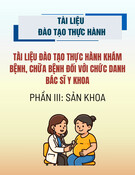

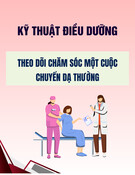






![Bài giảng Vi sinh vật: Đại cương về miễn dịch và ứng dụng [chuẩn nhất]](https://cdn.tailieu.vn/images/document/thumbnail/2025/20251124/royalnguyen223@gmail.com/135x160/49791764038504.jpg)

